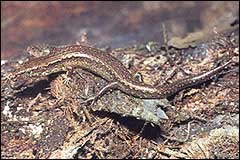|
|
|||
|
||||
|
Updated: September 12, 2001 |
|
|
|||||||||||||||||||||||||||||||||||||||||||||||||||||||||||||||||||||||||||||||||||||||||||||||||||||||||||||||
 Very little is known about the striped skink |
|
 Most native lizards hatch their eggs internally |
Lizards are varied in shape and have paired limbs usually with five toes. They are adapted for running climbing or paddling. Lizards have strong jaws with teeth.
A lizard's skin is made of tiny scales with few glands so they lose little water through their skins.
Lizards can be diurnal or nocturnal and they live in all sorts of places. Some live in trees, others on the ground, while some like to live by the sea. They rely on their environment for warmth.
Lizards often hear or smell their food before they see it. Their diet is mainly insects but they also eat berries and seeds. They may lick the nectar from flowers. Lizards help spread seeds and they also pollinate some types of flowers.
Lizards' ears are small openings located behind their eyes. Their nostrils are at the end of their noses.
Lizards are territorial and nearly all of them make noises. They have brightly coloured mouths to scare away predators and other lizards.
Most lizards lay eggs. The Suters skink is the only native lizard that lays eggs as all others give birth to live young. These females hatch their eggs internally.
The following table summarises facts about lizards and will be used in other parts of LEARNZ2001 for specific lizards.
|
|
|
|
|
|
|
|
Well developed neck |
Supports head |
|
|
Efficient jaw Tongue |
Licking eyes - geckos |
|
|
|
|
|
|
|
|
Lungs |
|
|
|
|
Smooth Dry Scales Coloured Few glands |
Camouflage Absorb heat Regrow tail |
|
|
|
Usually 5 toes |
Running Paddling |
|
|
|
|
|
|
|
|
|
Communicating with other lizards |
|
|
|
|
|